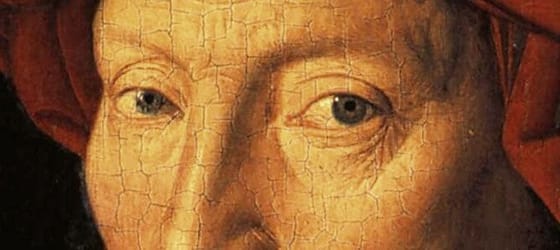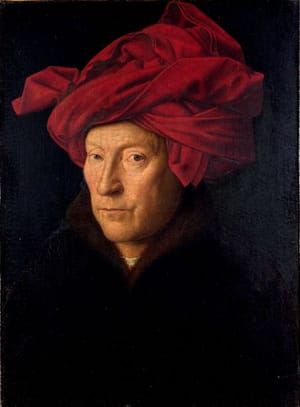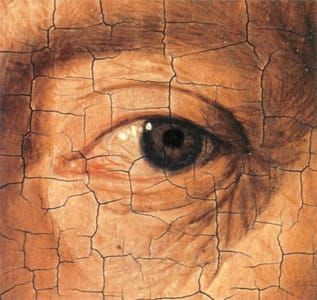

Portrait Of A Man In A Turban, 1433
Jan Van Eyck
https://www.youtube.com/watch?v=B9vXathZikM
The painting is signed and inscribed in an elaborate way on the frame, which is the original. The top inscription, which uses some Greek letters, is a punning allusion to the painter's name: 'Als Ich Can' (as I/Eyck can). The bottom inscription, in Latin, gives the name of the painter and the date: 'Jan van Eyck made me on 21 October 1433'. The letters are painted to look as though they have been carved.
The painting, so carefully inscribed, was presumably one of particular significance to the painter, and it has been suggested that it may be a self portrait. The direction of the man's gaze also suggests this.
Van Eyck uses light and shade in a subtle and dramatic way: the sitter seems to emerge from darkness, his face and headdress modelled by the light that falls from the left. The viewer is drawn towards the image by the penetrating gaze of the sitter.
[http://www.nationalgallery.org.uk/paintings/jan-van-eyck-portrait-of-a-man-self-portrait]
Maybe the earliest self portrait on panel, the painting is a portrait of a man dressed in a fur cloak and a chaperone on his head. It is thought that the portrait is probably a self portrait but there is no evidence to confirm that.
As in all of Jan's work we get a high sense of detail. The lines and shading of the chaperone is remarkable and in the face we can see natural movement and contours.
Jan gives us here a 3/4 profile view which he used in almost all of his portraits. The figures' lips are slightly pursed together and the character looks calm but pensive. The depiction of the face is certainly realistic while emphasizing the blood vessels visible in his face and wrinkles.
Portrayal:
Although similar to his other portraits, this overall lacks any emotional expression except a slight pensiveness which is almost comical below an extravagant headdress.
The character thought by some to be Jan largely by the inscription at the top and bottom of the frame: "Als Ich," meaning "As I can". The "Ich" is possibly a play on words being close to "Eyck. "
Also the Chaperone is folded up on top of his head. Normally the sides could be worn down but as Jan was always painting, he had to wear the sides up.
Follows a trend of his other portraits, the head is turned to the left while the eyes are fixed on the viewer.
Although the identity of the figure cannot be identified as Jan van Eyck in certainty, there are a few interpretations.
Interpretations:
Red was a color of clergy and here Jan painted himself as a clergyman or put himself on the same rank as them.
Jan is making fun of himself. The Chaperone puts the focal point at his brain and makes fun of the character.
[More at http://www.nationalgallery.org.uk/paintings/jan-van-eyck-portrait-of-a-man-self-portrait]
Portrait of a Man (Self Portrait?), (also Portrait of a Man in a Turban or Portrait of a Man in a Red Turban) is an oil painting by the Early Netherlandish painter Jan van Eyck, from 1433. It has been in the National Gallery, London since 1851, having been in England since Thomas Howard, 21st Earl of Arundel acquired it, probably during his exile in Antwerp from 1642-44.
The inscription at the top of the panel reads Als Ich Can, intended as "as I/Eyck can". It is, along with the unusually confrontational gaze, taken as an indication that the work is a self-portrait; probably his Portrait of Margaret van Eyck was a pendant.
The man is not, as it is commonly thought, wearing a turban, but a chaperon with the ends that normally hang down tied up over the top, which would be a sensible precaution if it was worn whilst painting.
[More at https://en.wikipedia.org/wiki/Portrait_of_a_Man_(Self_Portrait?)]
Uploaded on Jul 28, 2013 by Jim Luce
Jan Van Eyck
artistArthur
Wait what?


